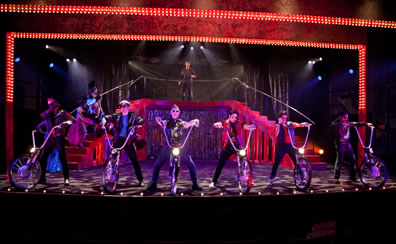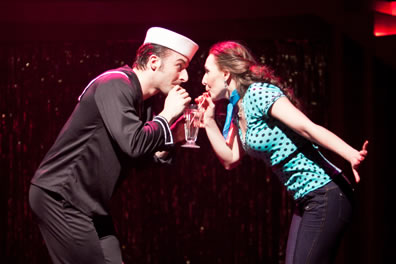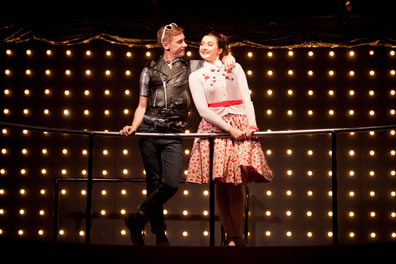Much Ado About Nothing
Something in the Way They Move
Synetic Theater, Arlington, Virginia
Sunday, February 15, 2015, D–104&105 (center stalls)
Directed by Paata Tsikurishvili, Choreographed by Irina Tsikurishvili

Don Pedro (Philip Fletcher, left) and his motorcycle gang arrive at Leonato's casino (Peter Pereyra on the upper stage) in Synetic Theater's production of William Shakespeare's Much Ado About Nothing. The bikers are, from left, Benedick (Ben Cunis) in the hat, Claudio (Scott Brown), Don John (Dallas Tolentino), Borachio (Pasquale Guiducci) and ensemble member Justin J. Bell. Photo by Koko Lanham, courtesy of Synetic Theater.
Any review of a William Shakespeare production must address it on two spectrums: one, as a Shakespearean work, and two, as theatrical entertainment. This is especially so with Synetic Theater, a dance and movement company based in Arlington, Virginia., and that twain has never been more divergent than with Synetic's latest (number 11) entry in its Silent Shakespeare series, Much Ado About Nothing. Director Paata Tsikurishvili's take on Much Ado as theater (with choreography by his wife, Irina) is laugh-or-gasp-a-minute entertaining, manifested in top-line dancing and some keen acting. As Shakespeare, well, the play drifts into a few sidetracks as Paata doesn't provide insights into interpretation so much as a guide on how to skirt the play's more problematic aspects, not just for nonspeaking Shakespeare theater but for any modernising adapter.
For the most part, Shakespeare's plays easily translate to ballet, dance, and other visual performance mediums, not so much due to his plays' plots but more for his employment of allegorical arcs, his portrayal of mental states, and his reach into the depths of human emotions through verse. Much Ado About Nothing, however, is a special case. Yes, there are mental states and human emotions, but the play doesn't utilize much in the way of metaphorical imagery, the play is mostly prose, and one of the two parallel plots, that of Beatrice and Benedick, is specifically word-driven: The pair combat each other in witty wordplay, they are gulled into falling in love with each other by overhearing their friends talking about them, and they woo in wit-impaired wordplay. Talking is both the engine and thematic arc of their story, and that's kind of hard to present in dance.
Meantime, the other plot, that of Hero and Claudio, is difficult to translate to the modern stage even using Shakespeare's words. That they fall in love is cool, but that Claudio's commander and patron, Don Pedro, courts Hero for him is archaic. That Don John, Don Pedro's bastard brother, sabotages the relationship by showing Claudio fake evidence of Hero making love to another man is workable only because Shakespeare makes sure the actual event happens offstage. That Claudio uses the wedding to expose Hero is extreme but certainly dramatic. That Don John's plot unravels when bumbling cops overhear his cronies talking about it is improbable but certainly comic. That the priest launches a scheme to fake Hero's death is rather unpriestlike, but Hero's father, Leonato, convincing Claudio to marry his niece as penance (but it's really Hero) is so far-fetched a golden retriever would give up on it.
Paata Tsikurishvili and adaptor Nathan Weinberger meet these challenges first with choice of setting: 1950s Las Vegas with a Marlon Brando meets Frank Sinatra esthete, plus some Elvis and James Brown thrown in. This allows them to make significant changes to the Hero-Claudio plot and provides the means and inspires the choreography to portray the Beatrice-Benedick plot.
The play actually begins on August 14, 1945, VJ Day. You know that iconic photograph of the sailor kissing the nurse on Times Square? That's Benedick (Ben Cunis) and Beatrice (Irina Tsikurishvili). Beatrice's obtuse hint in Shakespeare's play that they had a prior relationship is staged as a complete back story in Synetic's production as the two spend a happy day and night on the town. But then Benedick is torn: As his sailor buddies change from their Navy service dress blues into bike gang leather on one side of the stage, Beatrice is waiting for an appointed rendezvous on the other side. Benedick chooses the motorcycle way, donning a "Syneticom" leather jacket and a hat straight out of The Wild One.
The broken-hearted Beatrice ends up at her Uncle Leonato's casino in Las Vegas (Peter Pereyra plays Leonato as a slick operator with obvious mob connections). This becomes the setting for the rest of the play, with Daniel Pinha's set representing Vegas Fifties glamor: two grand staircases rising to an upper stage, a curtain of silver streamers in the middle, and the whole outlined in rows of lights. When that curtain is drawn, we see a wall of graffiti—Don John and his cohorts are vandals (the transition of scenes from casino to alley is accomplished by Brittany Diliberto's effectively moody lighting). Beatrice even becomes the star of the show in her uncle's casino, wearing a glittering gown and surrounded by burlesque showgirls and showboys as she sings "My Way" (actually lip-synching to a trumpet lead, so it's like Charlie Brown's teacher singing the popular song). "My Way," by the way, wasn't written until 1967, but we can overlook this anachronistic misstep because that Sinatra song so perfectly suits Beatrice.
That's when Don Pedro's motorcycle gang arrives (Pedro is a greaser played by Philip Fletcher). The bikes are presented as chopper handle bars on single wheels with shining headlights, and the actors push these around the stage to a soundtrack of motorcycle engines revving (Kasey Hendricks is props master, Konstantine Lortkipanidze is sound editor and resident composer, sampling everything from Chubby Checker and Bobby Darin to the Blues Brothers and Pink Floyd in the soundtrack). The bikers mime the vibrating effects of their engines roaring, the first of many such fine performance details the cast delivers throughout the play. In fact, so much comic stage business is going on in most scenes, you will need to see this show two or three times to take it all in.

Beatrice (Irina Tsikurishvili, right) dreams about her love for Benedick (Ben Cunis) recalling how they first met when he was still in the Navy on VJ Day in Synetic Theater's production of Much Ado About Nothing. Below, Claudio (Scott Brown) and Hero (Emily Whitworth) woo each other. Photos by Koko Lanham, Synetic Theater.
Now that we are into Shakespeare's play proper, the show kicks up a significant notch. The Beatrice-Benedick wit war is first played out as a card game. As she wins hand after hand, he removes his jacket, shirt, and eventually strips to his Valentine's hearts boxer shorts to buy more poker chips. Their battle continues with the masquerade dance, which sees the two of them quite literally getting into the foot-stompin', bump-and-grind music. The gulling scenes are cleverly managed as first Benedick's friends and then Beatrice's friends dress as the couple (her blue leather jacket, his hearts boxer shorts) and mime one pining for the other, who responds with disdain. The women achieve some of the show's biggest laughs as Margaret (Kathy Gordon) representing Benedick mimes ripping her heart from her breast and handing it, still beating in her hands, to Hero (Emily Whitworth) representing Beatrice. Hero mimes crumpling the heart, dashing it to the floor, stomping on it, and then blowing the pieces to the winds. Shakespeare gives Benedick and Beatrice soliloquies after they have been gulled into loving each other, and here these speeches are turned into dream-sequence dances. Thus does dance and movement suffice in carrying out the story of Beatrice and Benedick, and substituting witty mime for witty words maintains the original's comedy quotient.
As for the Hero-Claudio (Scott Brown) subplot, this production drops the proxy courting altogether, and Don John incriminates Hero by using darkroom magic to substitute Margaret's face with Hero's in pictures of Margaret's hook-up with Borachio (Pasquale Guiducci). Don John shows these photographs to Claudio who instantly becomes one of Don John's graffiti-painting minions. When he condemns Hero at their wedding, Claudio strips off her wedding dress and spray-paints graffiti on her. One keen departure at this point is Margaret's reaction: As Claudio and Don Pedro scatter the incriminating photos across the stage, Margaret picks some up, realizes the plot, and informs Leonato. Totally excised is Claudio's forced marriage to the cousin, but Hero's fake death remains, and she reveals herself to the shocked Claudio when he attends her wake to mourn her.
In a play of many fine moments, Hero's surprising Claudio tops all for one reason: Whitworth's playing of Hero, here giving a smug pose that encompasses both silly comedy and female power in one expression. Whitworth is a good dancer, but what she brings to Synetic shows is the acting skills of Buster Keaton and Charlie Chaplin combined: She speaks poetry with her face and sounds the depth of her heart with her expressive movement. Brown as Claudio is equally stellar with his athleticism in dance and his sincerity in emoting, and as a couple, this Hero and Claudio elevate their plot to equal status with that of Beatrice and Benedick. Being able to pull audience attention away from Tsikurishvili and Cunis playing the leads—both outstanding dancers and actors working with clicking chemistry in this production—is a Herculean feat by Whitworth and Brown, but they do just that in every one of their scenes.
 And yet, another member of the cast nearly steals the show: Dallas Tolentino as Don John. This production explains the bastard brother's tormented soul by turning him into a heroin addict. Another plot deviation, however, makes more sense: this Don John doesn't flee. He stays around to be captured by Dogberry (Vato Tsikurishvili) and Verges (Zana Gankhuyag who, with Justin J. Bell as a third deputy, play out their comic scenes as Sheriff Buford T. Justice cum Keystone Kops). This doesn't necessarily improve on Shakespeare—nor does it detract from original—but it certainly makes for a better Synetic show with Tolentino's acrobatic dancing and Elvis impersonations dominating the play's second half.
And yet, another member of the cast nearly steals the show: Dallas Tolentino as Don John. This production explains the bastard brother's tormented soul by turning him into a heroin addict. Another plot deviation, however, makes more sense: this Don John doesn't flee. He stays around to be captured by Dogberry (Vato Tsikurishvili) and Verges (Zana Gankhuyag who, with Justin J. Bell as a third deputy, play out their comic scenes as Sheriff Buford T. Justice cum Keystone Kops). This doesn't necessarily improve on Shakespeare—nor does it detract from original—but it certainly makes for a better Synetic show with Tolentino's acrobatic dancing and Elvis impersonations dominating the play's second half.
Another change in the plotline: Claudio and Benedick fight their duel, but they do it with jousting motorcycles. Claudio also gets into an extended knife fight with Don John early in the play. The Claudio–Don John fight establishes their enmity for each other only hinted at by Shakespeare but not clearly defined. The motorcycle duel, though, is just cool. However, while Synetic has earned fame for its staged combat sequences, with Cunis as fight choreographer, this production is excessive in its reliance on fights and mass brawls, most involving Don John's posse and Sheriff Dogberry's deputies. They make up a disproportionate share of the play's running time of just under two hours, including intermission.
While Paata Tsikurishvili manipulates key elements of Shakespeare's plot for his purposes, he also—as he always does in his Silent Shakespeare adaptations—unearths important gems buried in the original script that many straight play productions overlook. With this play, that gem is Friar Francis, who holds much potential comic and dramatic force as he presides over the aborted Hero-Claudio wedding, protects Hero from the wrath of her father, and then concocts the fake death scheme as he herds the couples to a double union at the end. Bell portrays the Friar's power of personality in the wedding scene, wielding his Bible as a shield against Leonato, yet remaining funny the whole while. After all, his hair is a conk pompadour, a la James Brown, and for the finale, he removes his priest's robes to reveal a suit of soul of another kind, a gold lamé one, and, WOAHHOWWWW! We feel good, we knew that we would now—so good.
So good is this production that any Shakespearean fault lines are easily mended in the performances—dancing, miming, and acting—of this cast. It may be "silent Shakespeare" but it's loud, it's poetic, it's romantic, and it's engagingly funny.
Eric Minton
February 18, 2015
Comment: e-mail [email protected].
Start a discussion in the Bardroom



 Find additional Shakespeareances
Find additional Shakespeareances